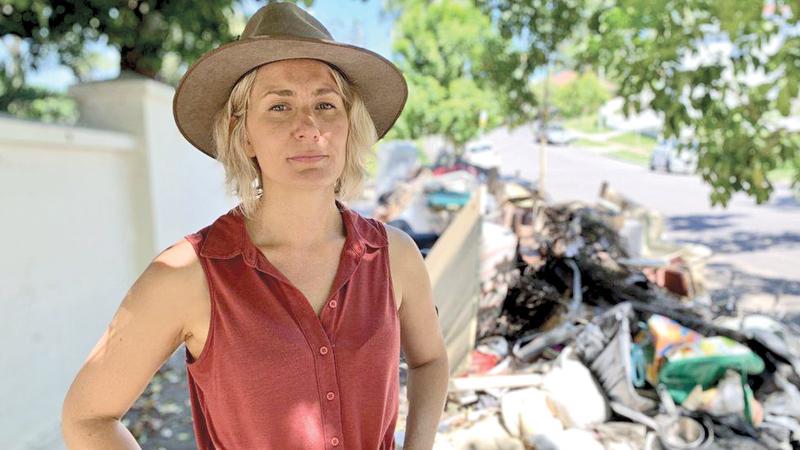
In the past two weeks, floods in eastern Australia have killed at least 21 people. Thousands of homes have been left uninhabitable by one of Australia’s worst natural disasters.
Wading through filthy, waist-high floodwaters to escape her apartment, Sophia Walter says her first emotion wasn’t fear. It was fury.
“What I felt was a real anger. Anger that this was happening again.”
In January 2011, Ms Walter watched “the hill I lived on turn into an island” as Brisbane suffered floods described as a once-in-a-century event.
“I remember thinking to myself, well at least I’ve gotten it out of the way.”
Barely a decade on, she is standing among mountains of abandoned furniture, destroyed electricals and sodden toys, all dumped on the footpath.
A “rain bomb” of intense downpours saw the city’s overflowing river and creeks cause billions of dollars of damage. At least five people in Brisbane have died.
With impeccable timing, as cars were being submerged, homes inundated and ferry pontoons cascaded wildly downstream, the Intergovernmental Panel on Climate Change (IPCC) was publishing its latest update on the state of the planet.
Among its many grim warnings: extreme rainfall (as well as droughts and bushfires) will become more and more common. And the window of opportunity to act is closing fast.
“There’s no way people can ignore it anymore,” says Guy Mansfield, a videographer who scrambled at midnight to save equipment and hard drives before floods consumed his basement office.
Precious photographs and music memorabilia were lost. A stack of destroyed furniture and books is piled outside the Brisbane home he only bought five years ago.
“It seemed astute to move into a flood area after the last flood, because it’s a little bit cheaper and we could afford a place here,” he says.
“We just thought it might flood again in 30 years or something like that, and we’d totally avoid it. But yeah, here it is. We couldn’t believe it.”
Ms Walter - a climate campaigner - aims her anger at Australia’s government for being slow to cut carbon emissions and invest in renewables.
“Despite the fact that we’re now seeing natural disaster after natural disaster, that this has become the new normal,” she says.
“I want to see more ambition, I want us to stop subsidising fossil fuels and to take up the job opportunities there can be in regional communities from renewable energy. Instead, it just feels like we’re languishing at the bottom of the pile.”
A report published at the COP26 global summit last year backs up that assessment. It ranked Australia last among 60 countries for policy responses to the climate crisis, largely down to a stubborn reliance on coal-powered energy and coal exports.
Like any standalone weather event, we can’t say how much a changing climate contributed to these specific floods.
But scientists are united in their view that global warming is making severe floods more likely in northern Australia.
Warmer oceans increase the amount of moisture moving from seas to the atmosphere, says Australia’s CSIRO government science agency. That will “most likely increase the intensity of extreme rainfall events”.
Brisbane got 80% of its average annual rainfall in just three days, with more water dropping on the city than typically falls in London over a year. Sydney has had its wettest start of the year on record.
But elsewhere in Queensland and New South Wales (NSW), flooding has been even worse. To the north of Brisbane, swollen rivers continue to cut off the town of Gympie.
In Lismore in northern NSW - where some residents scrambled to roofs and waited for 24 hours or more to be rescued - rebuilding will take years.
“Australia is getting hard to live in because of these disasters,” said Prime Minister Scott Morrison on a visit to the town on Wednesday.
“We are dealing with a different climate to the one we were dealing with before. I think that’s just an obvious fact.”
Challenged on his climate record, Morrison said the country had committed to reaching net zero by 2050 (though Australia was widely panned for not raising its crucial 2030 targets).
And he repeated his well-worn argument that reducing Australia’s 1.3% share of worldwide emissions would achieve little without a global response.
But campaigners say this ignores that Australia’s emissions are large for its population, while also neglecting that stronger action would send a message to the international community.
“There’s been no meaningful climate action in eight years. This is a resounding failure,” said Amanda Mackenzie, chief executive of the Climate Council.
In May, Australians are likely to vote in national elections - the first since the Black Summer bushfires.
With these floods fresh on the mind, the costs of climate change - environmental, human and financial - seem certain to play a big part.
Flood insurance claims look set to reach A$2bn ($1.5bn), putting them on par with those bushfires.
Mansfield says he is not fully insured, but did at least have some coverage. Neighbours were even less fortunate. – BBC
